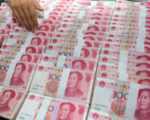China’s State Planner Announces Economic Boost but Holds Back on Major Stimulus

During a highly anticipated press conference on Tuesday, Zheng Shanjie, chairman of China’s National Development and Reform Commission (NDRC), outlined a series of measures aimed at strengthening the country’s economy. Despite these efforts, there were no announcements of major new stimulus initiatives, dampening investor enthusiasm and causing the rally in Chinese markets to lose momentum.
One key announcement was the acceleration of special purpose bond issuance to local governments, intended to support regional economic growth. Zheng emphasized that the 1 trillion yuan in ultra-long special sovereign bonds had been fully allocated to local projects. He also pledged to continue issuing ultra-long special treasury bonds next year. In addition, the central government will release a 100 billion yuan investment plan for 2024 by the end of this month.
The press briefing came as mainland China’s markets reopened after the weeklong Golden Week holiday. While markets initially surged on the news, the lack of significant new stimulus caused gains to slow. The CSI 300 blue-chip index pared its rise to 5% after an early jump of over 10%, while the Shanghai Composite and SZSE Component indices also trimmed gains to 5% and 8%, respectively.
Limited Stimulus Falls Short of Investor Expectations
Although Zheng expressed confidence that China would meet its annual growth target, his comments on the property market and domestic spending lacked detailed financial commitments, leaving some investors disappointed. Yue Su, an economist at the Economist Intelligence Unit, noted that the absence of specific figures might not be a negative indicator, as China’s pro-growth policy stance remains unchanged. Su maintained her forecast of 4.7% growth for China in 2023, with a slight uptick to 4.8% in 2025.
Shaun Rein, managing director at China Market Research Group, commented that many Western investors might take a cautious approach following the announcement. He added that without concrete fiscal stimulus, the recent rally in Chinese markets could be short-lived.
Economic Struggles Persist
China has been grappling with a sluggish economy following a disappointing recovery from COVID-19 lockdowns. Growth in the world’s second-largest economy has been hindered by weak domestic demand and a prolonged downturn in the property sector.
In the first half of 2023, China’s economy grew by 5%, meeting government targets. However, in the second quarter, growth slowed to 4.7%, marking the slowest pace since the first quarter of 2023. Inflation data has also been lackluster, with consumer prices rising by just 0.6% year-on-year in August, missing expectations. Factory activity contracted for the fifth consecutive month in September, with the official Purchasing Managers’ Index (PMI) recording 49.8, signaling continued contraction in the manufacturing sector.
Zheng acknowledged that China still faces significant challenges in achieving its growth objectives. Earlier in the year, he had emphasized the importance of coordinated macroeconomic policies, including fiscal, monetary, employment, and industrial measures, as the country continues to adjust its economic strategies.
While Beijing has introduced several stimulus measures aimed at halting falling property prices and bolstering economic performance, these actions have yet to fully reverse the slowdown. Investors remain cautious, awaiting further fiscal support from the government to reinvigorate the economy.





















